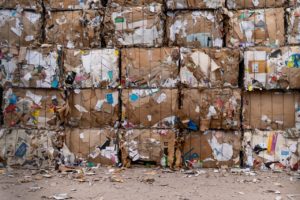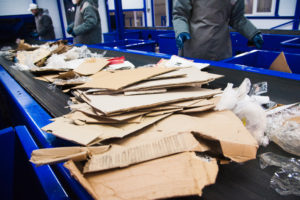Paper and paperboard (cardboard) are used in practically every industry. Often considered disposable, it’s an increasingly precious resource as unsustainable deforestation continues around the world.
Fortunately, both paper and cardboard have been the focus of recycling campaigns for decades, and as processes become more efficient, more products have been manufactured from recycled material—but how effective is the paper and card recycling process, and how does paper recycling work?

How effective is the paper and cardboard recycling process?
According to the Environmental Protection Agency (EPA), there were 67.4 million tons of paper and paperboard as part of the municipal solid waste (MSW) total in the United States in 2018. That equates to 23.1% of the total MSW that year. More importantly, 68.2% of that paper and paperboard was recycled – 46 million tons – which is the highest recycling rate of any of the materials in MSW.
The recycling rate does vary depending on the product, however, with some of the discrepancies in the paper and cardboard recycling process being seen here:

This also means that not all paper and cardboard makes it into the recycling process, and this is due to a number of reasons.
What are the limitations of the cardboard and paper recycling process?
One major limitation of the paper recycling process is that each time fibers go through it, they are shortened. This means that paper and card can only be recycled four to six times before becoming unusable. When compared to other commonly recycled materials, paper and card can withstand much less processing. Plastic, for example, can be processed seven to nine times, and aluminum and glass can be recycled any number of times without loss of quality.
Multi-material products can pose a problem for existing systems, so separation of these where possible before they are processed is both necessary and time-consuming Additionally, there are certain products that must be excluded from the paper and cardboard recycling process from the beginning.
 Soiled Items
Soiled Items
Soiled paper can’t be recycled and shouldn’t be included with other paper and card products. Soiled does not mean printed on, but rather refers to contaminants such as oil. Therefore, items such as pizza boxes lined with grease, napkins, take-out boxes, and used paper plates must be separated and sent to landfill or incineration. If they do end up in the recycling bin, the oil in them can contaminate the entire paper slurry (part of the recycling process for paper) and ruin otherwise recyclable items.
 Coated Paper
Coated Paper
Paper that is coated in plastic, wax, or foil is generally not recyclable, meaning products like juice cartons must also be thrown away. That said, there have been significant advances in recycling in recent years, so check with your local provider as some are now accepting certain coated papers into the recycling process.
When items do make it into the paper recycling process, not all are equal in quality. The type and grade of paper or card determine how it is dealt with and what it becomes.
What are the types and grades of paper and card?
There are four basic categories of paper and cardboard in the paper recycling process, as outlined by the EPA. These are:
Old Corrugated Containers (OCC)
Commonly called corrugated cardboard, this is what most shipping boxes are made of. An increasingly common item for recycling both at home and at work as online shopping and delivery services continue to grow. OCC is often processed into new corrugated cardboard boxes and paperboard, which is used in products like cereal boxes and shoe boxes.
Mixed Paper
This is where the large bulk of paper products will fit. It covers everything from magazines and catalogs to junk mail and paperboard. This is also the category in which shredded paper will usually fall. Items in this category are often turned into new paperboard and tissue or as a secondary fiber for other paper types.
Recycled mixed paper is also used in the production of other, sometimes unexpected, products such as drywall, insulation, and roofing felt.
Old Newspapers (ONP)
This is a rather self-explanatory grade, consisting only of newsprint. ONP is most often turned into new newsprint, but can also be used for paperboard and tissue.
High-Grade De-inked Paper
This category covers office paper, envelopes, etc. Just as the name describes, the paper must be de-inked before it can be repurposed into new high-grade products.
How is cardboard and paper recycled step by step?
1. Collection
The card and paper recycling process starts with collection. Being one of the most popular targets of recycling, paper and card is often eligible for curbside collection. Businesses may need to look into private paper recycling collection, especially if they deal with large quantities.
Businesses that deal with any kind of private data – whether their own records or customer details – can simplify their process by looking for a service that combines confidential shredding, storage, and recycling.
2. Separation by Type and Grades
Paper and cardboard is then separated by the types and grades outlined above. This is important to ensure that high-quality fibers aren’t tainted by low-quality ones. This is much more obvious for some categories than others, such as newsprint most often being made of recycled newsprint, as opposed to recycled boxes, for example.
3. Cleaning and Filtering
The paper is then chopped, broken up, heated, and mixed with water to create a slurry. This is then strained to filter out plastic, staples, and other contaminants. Chemicals are used to de-ink the paper slurry.
4. Processing
The slurry is then broken down further in order to go from a mixture of broken paper into an actual slurry of fibers suspended in water. Additives such as colorants and thickeners are then added depending on the end product.
5. Drained and Flattened
The slurry is then spread or sprayed onto mesh sheets to get rid of the water and create a thin layer of fibrous pulp. This is the point at which it will often have virgin wood fibers mixed in before being processed further. The exact amount of recycled to virgin fibers depends on the product and the manufacturer. The EPA does outline some suggestions, which we will take a look at later.
6. Formation
The sheet of fibrous pulp is passed through rollers to squeeze it thinner and remove more of the water. It is then fed through heated rollers (or similar) until the continuous roll of paper reaches the desired thickness and has dried. The paper is then rolled up and sliced into smaller sections for transportation and processing into final products.
The EPA’s Comprehensive Procurement Guidelines for Paper and Paper Products
The Comprehensive Procurement Guideline (CPG) Program is part of the broader Sustainable Materials Management initiative by the EPA. It aims to reduce the use of materials and the impact they have across their lifecycle. Specifically, it promotes the recovery of materials from Municipal Solid Waste, including paper and cardboard.
The EPA’s guidelines for paper and cardboard focus on the minimum recommended percentage of recovered fiber used in various products. This includes the total recovered fiber as well as the percentage of postconsumer fiber. It excludes newsstand returns or printer overruns. The percentage of post-consumer fiber is often a better gauge of the paper and cardboard recycling process as this is material that has been in consumers’ hands and followed by the entire recovery process.
The EPA groups the paper and cardboard products into five main categories:
Printing and Writing Papers
By far the biggest category, this includes products like office paper, stationery, and note pads. For example, high-speed copier paper is recommended to have a minimum content of 30% post-consumer fiber and 30% total recovered fiber.
On the other hand, cards (index, postal, etc) are recommended to have a minimum of 20% post-consumer fiber but 50% total recovered fiber, meaning the difference could be made up from overprints or other sources.
Newsprint
This category is a single paper type that is almost exclusively used to print newspapers. Unlike Printing and Writing Papers, the EPA gives a range of recommendations here of 20% to 85% postconsumer fiber and 20% to 100% total recovered fiber.
Commercial/Industrial Sanitary Tissue
This category covers bathroom and facial tissue, napkins, paper towels, and general-purpose commercial paper wipes. It focuses on commercial products for restaurants, hotels, schools, government agencies, etc., rather than home use, so is a good guide for businesses looking to make their paper procurement more sustainable.
For example, paper towels have a recommended minimum of 40% to 60% post-consumer fiber while facial tissue can be as low as 10% to 15%.
Paperboard and Packaging
Another significant section, it includes corrugated containers (aka. containerboard), which is what is used for most boxes shipped, and paperboard which is commonly used for packaging like cereal boxes. Some examples from this category are folding cartons (made of paperboard), which are recommended to have a minimum of 40% to 80% post-consumer fiber. Padded mailers on the other hand require just 5% to 15%.
Miscellaneous Paper Products
A category of only one product – tray liners. This is paper used to line food trays in commercial restaurants and industrial food services. It is recommended to be a minimum of 50% to 75% postconsumer fiber and 100% total recovered fiber.
Turning the page on paper waste
The paper and cardboard recycling process may seem like a relatively simple one compared with other materials, such as plastic, but it still requires energy, resources, time, and money. Additionally, while these materials are generally biodegradable, wasting virgin paper by sending it to landfill or incinerating it places a heavy burden on our forests, as well as the waste management infrastructure.
Sustainable waste management plans begin with reducing waste and reusing products wherever possible before they are sent for recycling. In this way, we can minimize the impact of both manufacturing and recycling processes, as well as keep manufactured materials in the loop for as long as possible.
To get started on your business’s sustainable waste management plan, contact our TRUE advisors today, and for more insights into recycling and sustainability, subscribe to the RTS blog.













